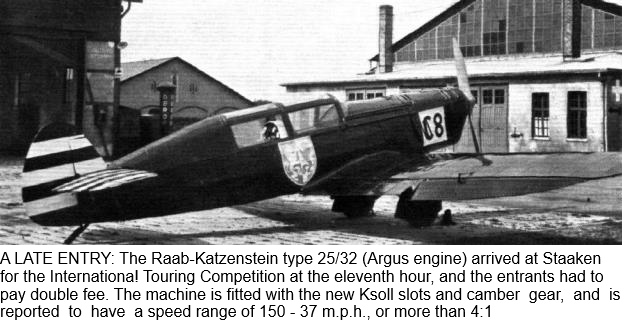| Type |
Two seat sportplane |
| Engine |
1 Argus As 8R |
| Dimensions |
Length 6,50 m, height 2,0 m , span 9,30 m, wing area 13,00 m2. Volume with folde wings 3,0 x 3,0 x 7,0 m |
| Weights |
Empty 430 kg, flying weight 700 kg, wing loading 54 kg/m2 |
| Performance |
Max. speed 235 km/h, service ceiling 4500 m, range 1200 km, climb 4,0 m/sec,, landing speed 65 km/h |
In 1932 the first prototype (D-1489) was rebuilt as the RK.25/32 for the Challenge International de Tourisme 1932. This had an enclosed cabin with large side and upper glazing panels, inboard Ksoll slotted, camber-changing flaps and independent, faired undercarriage legs. It was powered by a 93 kW (125 hp) Argus As 8 air-cooled, four cylinder, inverted inline engine[ and had a maximum speed about 240 km/h (150 mph)
The RK.25/32 took part in the 1932 Challenge, though it was late and only admitted after the payment of a fine. It performed badly in the tests before the tour, coming last of forty-one and engine problems forced it out of the tour at Rimini.
| Type |
Werk.Nr |
Registration |
History |
|
85 |
D-1489 |
Modified RK 25. Sept. 1928. Luftfahrtverein Essen. Greiling Zigarettenfabrik, Dresden. Planned to take part in the Europa-Rundflug 1932. Did not fullfill the race because of damaged engine. Destroyed Jan. 1932 |


RK 25/32
The low-wing RK25, built at the time by the Raab-Katzenstein aircraft factory, has been redesigned and fitted with Ksoll split and folding wings. The RK25, with a cruising speed of 250 km/h, won third place in the overall classification in the 1929 European Flight and achieved the highest average speed of the 40 participating aircraft.
The new RK 25/32 is equipped with a 130 hp Argus As 8 engine, has a split axle, wheel fairing boxes and individual wheel brakes. Pilot and passenger sit in the
closed cabin of the aerodynamically extremely carefully designed fuselage. The wings are split at the fuselage and are foldable. The take-off and landing flaps, which work according to the angle of attack adjustment system, reduce the landing speed by around 40 percent compared to the previous speed and significantly shorten the run-up area during take-off.

